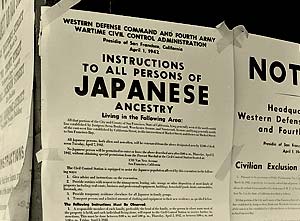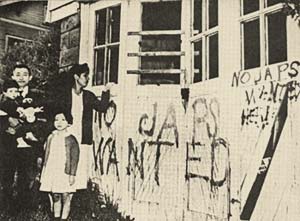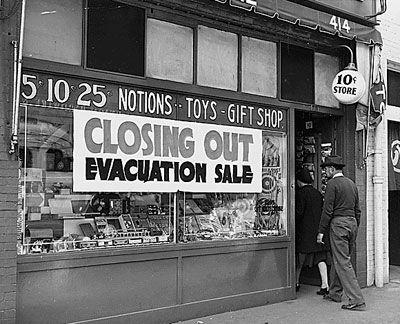Roosevelt Starts the Process
 Signs give instructions to Japanese Americans and nationals in the wake of the signing of Executive Order 9066 by President Roosevelt. (Image courtesy National Archives, Truman Library)
Signs give instructions to Japanese Americans and nationals in the wake of the signing of Executive Order 9066 by President Roosevelt. (Image courtesy National Archives, Truman Library)
On Feb. 19, 1942, President Roosevelt issued Executive Order No. 9066 and put to rest more than two months of intense speculation and lobbying about the fate of Japanese Americans during World War II. By September more than 110,000 Japanese Americans had been uprooted from their jobs and homes, denied their civil rights, and interned in camps surrounded by barbed wire in the single largest forced relocation in American history.
Proclamations and Confusion
Executive Order 9066 empowered the secretary of war or designated military commanders to prescribe military areas and to exclude "any or all" persons from them. While couched in broad terms, the order was aimed at Japanese Americans. Less than two weeks later, Lt. General J.L. DeWitt, commanding general of the Western Defense Command and Fourth Army, was more specific. His Public Proclamation No. 1 defined Military Area No. 1 and No. 2 running north-south from the Canadian border to Mexican border. In Oregon, these areas roughly were divided by Highway 97 in Central Oregon with Area No. 2 lying to the east. DeWitt signaled that he would soon issue Civilian Exclusion Orders to clear the "exclusion area" of Military Area No. 1 in Western Oregon along with territory in other western states.
Voluntary Relocations and Increased Restrictions
 Japanese American families endured discrimination and vandalism in the run-up to relocation. (Image courtesy latinamericanstudies.org)
Japanese American families endured discrimination and vandalism in the run-up to relocation. (Image courtesy latinamericanstudies.org)
Before mandatory evacuations were imposed, the federal government encouraged voluntary resettlement outside of the demilitarized zone. As a result, some Japanese Americans attempted to move inland but they often met with resistance from a Caucasian population fearful of unsupervised aliens. Masaomi Kibe's family tried to relocate from Tacoma, WA to a farm near Merrill in Klamath County with the intention of farming on a friend's property. They complied with all rules and regulations and secured a permit
from authorities to make the move. The family simply wanted to be self-supporting and "avoid becoming government charges in a concentration camp."
Their problems began quickly, however, when the Klamath County Sheriff took them into custody with no end in sight "because he fears mob violence if they move into the Merrill neighborhood. For two weeks they have been couped [sic] up in a dark, dingy apartment while the sheriff has tried to obtain a permit to move them back to Tacoma." The Kibe family was caught in a bureaucratic nightmare. They had been issued a valid permit to move to Merrill. But days later General DeWitt had announced that voluntary evacuations would cease and all future "evacuation would be on a planned, orderly basis to War Relocation Authority relocation camps." A friend pleaded with Governor Sprague's office for help and was told that "they are to be escorted to Portland when the military authority issues the necessary order, and they will be cared for as other Japanese of the coastal area are to be cared for."
Footnote 1
Restrictions increasingly constrained Japanese Americans during the spring. Andrew Kuroda, a Japanese American minister from the Salem area, summed up the situation in a letter to friends:
Exclusion Orders for Oregon
Authorities issued exclusion orders based on the most sensitive and critical zones in the military area. Civilian Exclusion Order No. 1 ordered those of Japanese ancestry to evacuate Bainbridge Island by March 30. The controlled process of relocation began for the Japanese population of Multnomah County by the issuance of Exclusion Orders Nos. 25 and 26. No. 25 applied to about 950 people who lived west of the Willamette River while No. 26 affected those to the east of the river extending further east to 122nd Avenue.
 Despite efforts by government officials to limit the impact, many Japanese Americans disposed of their assets for a fraction of true value before their forced relocation. (National Archives, image no. ARC 299687)
Despite efforts by government officials to limit the impact, many Japanese Americans disposed of their assets for a fraction of true value before their forced relocation. (National Archives, image no. ARC 299687)
The order required that each Japanese head of household report to one of two Army directed Civil Control Stations on April 29 or 30, 1942 to register for movement to an assembly center. The evacuees also provided information on a social data registration form, including the name, sex, age, birthplace, education, occupation, alien registration number and physical condition of each family member.
Footnote 3 Evacuees received instructions on how to arrange for movement, how to prepare household goods for storage, and when to be ready for transfer to the Portland Assembly Center. Exclusion orders for other Oregon locations soon followed.
Evacuees had only a few days to get their affairs in order before they had to report to the Portland Assembly Center that was part of the internment process. Homes, businesses, and farms had to be disposed of on extremely short notice. Bargain hunters, fully aware of the situation, stood ready to purchase the property and belongings at a fraction of their true value.
To combat this, the Civil Control Stations were staffed by representatives of a number of federal agencies to offer advice and assistance to the evacuees on how to avoid forced sales and otherwise "cope with the multitude of problems involved in suddenly cutting off the normal business, social and economic relationships of the evacuees." For example, the U.S. Employment Service offered registration and provided welfare service; the U.S. Health Service gave examinations and inoculations; the Federal Reserve helped with the sale, lease, or management of property; and the Farm Security Administration arranged for new operators to work evacuated farms to limit the loss of crop production.
 National Reclamation Association Bulletin Footnote 4
National Reclamation Association Bulletin Footnote 4 To further ease the transition, Portland area Japanese Americans were allowed to store personal property in the Oregon Transfer Company Building.
Footnote 5
The evacuees could take only a small amount of personal belongings to the assembly center. Within a dizzying few days, Japanese Americans lost not only their property but also their civil rights and freedom. One Japanese American observer noted: "No one understands what our hardship and suffering means unless one is among the evacuees. Uprooted from their businesses, jobs, lands, they have to be dispossessed of whatever they have toiled hard to gain for the past half century."
Footnote 6
Related Document
 Public Proclamation No. 1,
Public Proclamation No. 1,
Headquarters Western Defense Command and Fourth Army, March 2, 1942. Folder 23, Box 32, Defense Council Records, OSA.
Notes